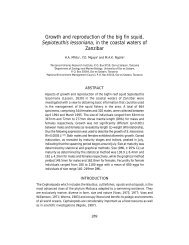gpa_east_africa_case.. - GRID Africa GeoPortal - UNEP
gpa_east_africa_case.. - GRID Africa GeoPortal - UNEP
gpa_east_africa_case.. - GRID Africa GeoPortal - UNEP
You also want an ePaper? Increase the reach of your titles
YUMPU automatically turns print PDFs into web optimized ePapers that Google loves.
• The clearing of mangroves, coastal and kaya forests, and increased development and usesof the beach have resulted into the erosion of the beaches and the coastline with theconsequent losses of nestling habitats for turtles and loss of scenic and aesthetic qualitiesfor tourism.• Decline in water quality, beach erosion and sedimentation have also led to the degradationof sea grasses.• Fish habitats (Coral reefs and mangroves) have been degraded with consequent loss ofbreeding and spawning habitats for fish leading to decline in fish production.• Reduced fish production also reduces incomes to fishermen with corresponding increasedprices for buyers.• Public health threats associated with drinking contaminated water, the consumption ofcontaminated seafood and recreational contact.• Degraded environmental quality results in the decline of tourist visits and loss of means oflivelihood to boat and tour operators from businesses and tourism associated revenues.Health Impacts and threat - Indicators of Health Problems. Due to various types of waterborne diseases, which afflict children, the source of water for domestic use has and methodsof sewage disposal direct affect the level of child mortality and morbidity. It is reported in theKenya Population Census (1989) Analytical Report on Child Mortality that the proportions ofchild mortality was directly related to the various sources of water in relation to their qualityattributes. Lakewater was reported as the most important factor responsible for high childmortality. Important differences are reported in child mortality by means of sewage disposal, akind of dose-response function: The use of main sewer yielded the lowest proportions of childmortality, while disposal of sewage in the bush resulted in the highest child mortality. Onaverage, use of the bush disposal method increases child mortality by about 53% ascompared to use of main sewer. Indiscriminate use of small plastic containers to dispose ofwaste matter is commonplace in Mombasa, a phenomenon commonly referred to as “flyingtoilets”. Such disposal methods are common responses to the lack of infrastructure underconditions of rapidly growing population, poverty and public sector financial stringency.Spontaneous methods of waste disposal are contributory factors to the prevalence of waterbornediseases such as malaria, diarrhoel diseases and worms. These diseases have been themajor causes of death among the infants as reported above. According to the Economic Surveyof 1996, the mortality rate in Mombasa was 60/1000 for infants under 1 year.The national average reported was 66/1000. No statistics could be found for children betweenthe ages 1 and 5 years for the same period for Mombasa. However, national statistics for 1998indicate that mortality in general has gone up across the board. This increase in mortality isattributed to the HIV/AIDS pandemic. Figures cited indicate mortality of 74/1000 for infants and112/1000 for children between the ages 1 and 5 years.Malaria has been singled out as the major cause of death among children between the ages of1 and 5 killing 107/1000 children. It kills 72 children daily and accounts for 30% of all outpatient<strong>case</strong>s and 19% of admissions, 5.1% of who die. The major diseases reported in Mombasainclude malaria, pneumonia, tuberculosis, diarrhea and anemia. Recently typhoid has emergedto as one of the most devastating water-borne disease. In 1994, malaria constituted 33.4% of all<strong>case</strong>s reported, while pneumonia was 19.5%. Tuberculosis recorded 19.8%; diarhoeal diseasesconstituted 8%, while the rest recorded 19.1%.Out Patient Morbidity in the District of Mombasa 1994Diseases Island Kisauni Changamwe Likoni Total %MalariaRespiratorySkin InfectionDiarrhoeaOthers43,73232,53312,53410,18421,36525,80916,07810,7228,5175,67931,92114,7038,6027,6374,64825,56010,8225,9284,2054,757127,02274,13675,57230,54372,89833.419.519.88.019.1Source: Municipal Council of MombasaA <strong>case</strong> is reported in February-March 1999, in Mombasa, where a sewer line burstcontaminated the main reticulated water supply with the following consequences: 470 out ofFinal Draft Report – Cost Benefit Case StudiesGPA Strategic Action Plan on Sewage, October, 200075



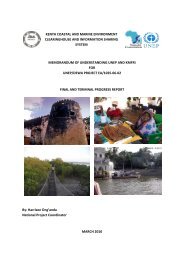
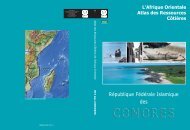
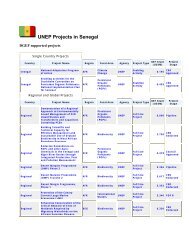

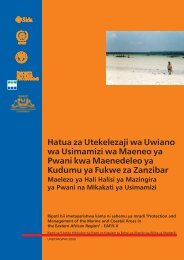
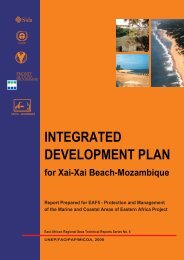
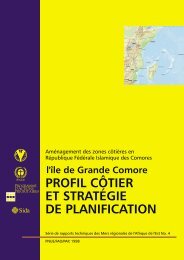
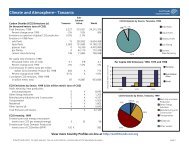

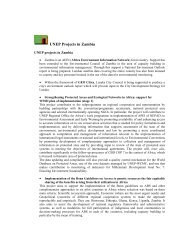
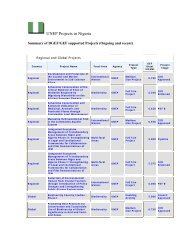
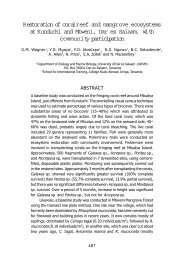
![Please Click to download [English] - GRID Africa GeoPortal - UNEP](https://img.yumpu.com/30633391/1/184x260/please-click-to-download-english-grid-africa-geoportal-unep.jpg?quality=85)
